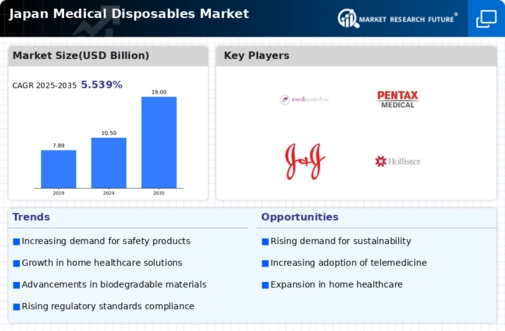Rising Healthcare Expenditure
The increasing healthcare expenditure in Japan is a pivotal driver for the medical disposables market. As the government allocates more funds towards healthcare, the demand for medical disposables is likely to rise. In 2025, healthcare spending in Japan is projected to reach approximately $500 billion, reflecting a growth rate of around 3% annually. This financial commitment facilitates the procurement of advanced medical disposables, which are essential for effective patient care. Furthermore, the aging population in Japan necessitates a greater reliance on disposable medical products, as they are crucial for maintaining hygiene and preventing infections. Consequently, the medical disposables market is expected to benefit significantly from this upward trend in healthcare investment.
Regulatory Framework Enhancements
Enhancements in the regulatory framework governing medical devices are influencing the medical disposables market. In Japan, the Pharmaceuticals and Medical Devices Agency (PMDA) has implemented more streamlined approval processes for medical disposables, which is expected to facilitate quicker market entry for innovative products. This regulatory support is crucial for manufacturers aiming to introduce new disposable products that meet evolving healthcare needs. As a result, the medical disposables market is likely to witness an influx of innovative solutions, contributing to its growth. Furthermore, compliance with stringent safety standards ensures that products are reliable, thereby boosting consumer confidence and market demand.
Increased Focus on Infection Control
The heightened focus on infection control in healthcare settings is a significant driver for the medical disposables market. In Japan, hospitals and clinics are increasingly adopting stringent infection prevention protocols, which necessitate the use of disposable products. The market for infection control disposables is projected to grow by 10% annually, driven by rising awareness of healthcare-associated infections (HAIs). This trend is further supported by government initiatives aimed at reducing HAIs, which include guidelines promoting the use of single-use medical devices. As healthcare facilities prioritize patient safety, the demand for medical disposables is expected to surge, thereby positively impacting the market.
Technological Innovations in Product Design
Technological innovations play a crucial role in shaping the medical disposables market. The introduction of advanced materials and manufacturing techniques enhances the functionality and safety of disposable products. For instance, the development of biodegradable materials is gaining traction, aligning with environmental sustainability goals. In Japan, the market for eco-friendly medical disposables is anticipated to grow by 15% annually, driven by both consumer demand and regulatory pressures. Additionally, innovations such as smart disposables equipped with sensors for monitoring patient conditions are emerging. These advancements not only improve patient outcomes but also streamline healthcare processes, thereby propelling the medical disposables market forward.
Growing Demand for Home Healthcare Solutions
The growing demand for home healthcare solutions is reshaping the medical disposables market landscape. With an increasing number of patients opting for home-based care, the need for disposable medical products is on the rise. In Japan, the home healthcare market is projected to expand by 12% annually, driven by an aging population and a preference for personalized care. This shift necessitates the availability of medical disposables that cater to home care settings, such as wound care supplies and diagnostic kits. As healthcare providers adapt to this trend, the medical disposables market is likely to experience substantial growth, reflecting the changing dynamics of patient care.















Leave a Comment